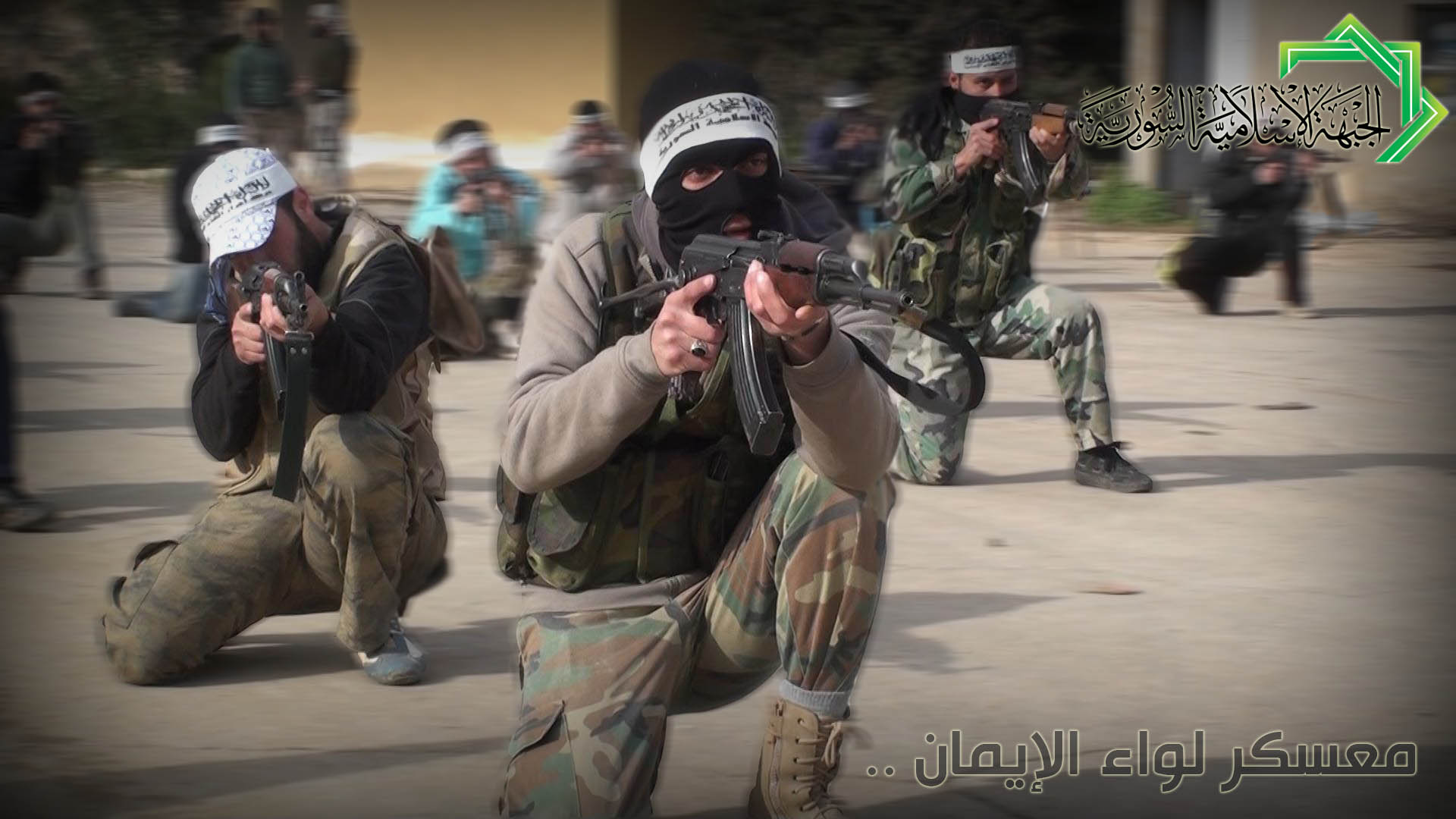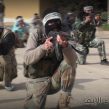
Ahrar al-Sham: A Profile of Northern Syria’s al-Qaeda Surrogate
Publication: Terrorism Monitor Volume: 11 Issue: 7
By:

The uprising against Syrian president Bashar al-Assad’s rule entered its third year in March. The process of disaggregating the political and armed currents that are struggling against the Ba’athist regime, however, remains an exercise in futility. Despite ardent efforts by the numerous opposition factions to portray an image of ideological moderation, the preponderance of evidence indicates that radical Islamists dominate the Syrian insurgency. Jabhat al-Nusra, a radical Salafist organization that is acting as al-Qaeda’s surrogate in the conflict, has solidified itself as the most deadly insurgent faction fighting in Syria today. Yet other similarly motivated extremist formations are also making their presence felt. It is against this background that the activities of the Kata’ib Ahrar al-Sham (Free Men of Greater Syria Brigades, hereafter referred to as Ahrar al-Sham), a radical Salafist faction operating largely in northern Syria, warrant a closer look.
Ahrar al-Sham has consolidated its influence in strategically important theaters across Syria, including portions of Syria’s second city of Aleppo and its environs as well as vital supply and communication lines extending to Turkey (al-Monitor, January 13). It has also reportedly engaged Syrian security forces in some of the fiercest combat witnessed since the militarization of the uprising, including a series of fierce battles for control of a number of military air bases and civilian airports in January and February (al-Safir [Beirut], January 30; al-Jazeera [Doha], February 12). Perhaps most importantly, the instrumental role played by Ahrar al-Sham in the formation of the Syrian Islamic Front (SIF), an association of eleven like minded Salafist militant factions that came together in common cause in December 2012, is emblematic of its growing influence. [1] Ahrar al-Sham is widely reputed to maintain a dominant presence within the SIF. [2] In another sign of its expanding authority, a number of fellow Salafist insurgent groups merged under Ahrar al-Sham’s leadership structure to form the Harakat Ahrar al-Sham al-Islamiya (The Islamic Movement of Ahrar al-Sham) in January 2013 (AFP, February 13).
Details surrounding the precise origins and leadership of Ahrar al-Sham remain murky. The group is believed to have organized in late 2011 and is reportedly led by Abu Abdullah al-Hamawi. While the nisbah portion of his name suggests that he hails from Hama, it has also been reported that he hails from Aleppo (al-Monitor, January 13). [3] Ahrar al-Sham’s founding members are said to be former political prisoners who were incarcerated in the infamous Sednaya Prison located just outside of Damascus until they were granted amnesty in May 2011. While it welcomes foreign-born militants into its ranks, Ahrar al-Sham boasts of its mostly Syrian-born membership (al-Monitor, January 13; AFP, February 13). Ahrar al-Sham’s influence is centered largely in Syria’s northern governorates of Idlib, Aleppo and Raqqa and, to a lesser extent, the western-central governorates of Hama and Homs. An accurate estimate of its membership is difficult to discern. An alleged member of the group asserted that Ahrar al-Sham commands between 5000 and 6000 fighters in Aleppo governorate alone, a figure that is likely to be inflated for propaganda purposes (al-Monitor, January 13). Tens of regional-based detachments likely organized around local village, town and city networks operate under its auspices.
Ahrar al-Sham’s track record to date is fraught with contradictions. From an ideological perspective, Ahrar al-Sham has declared its objective to transform Syria into its image of an Islamic state. Members of Ahrar al-Sham have stated that their conception of an Islamic state would protect religious minorities and be based on the premise that the majority of Syrians, who are Sunni Muslims, would choose to live in an Islamic society (Daily Star [Beirut], February 13; al-Akhbar [Beirut] January 5). Yet its official discourse is replete with extremist themes and symbolism informed by its radical Salafist pedigree. Ahrar al-Sham’s frequent resort to sectarian diatribes targeting Alawites and Shiite Muslims, both of whom are viewed by hardline Salafists as heretical, is often cited as a point of concern.
Ahrar al-Sham also draws ideological support from the likes of radical Salafist ideologues such as the Syrian exile cleric Shaykh Adnan al-Arour, a leading advocate of the radical Salafist movement in Syria from his base in Saudi Arabia. The group also counts on the largesse of wealthy financiers based in the Persian Gulf and regional governments such as Qatar and Saudi Arabia that are funneling weapons to the front (al-Akhbar, January 5; al-Monitor, January 13). In a sign of things to come in a hypothetical post-al-Assad scenario, areas that have fallen under the control of Ahrar al-Sham and similarly minded militants, including some regions that were regarded as bastions of popular opposition to the Ba’athist regime, are reported to have witnessed the looting of local businesses and the unwelcome imposition of ultraconservative Islamic dictates on everyday social and civil life (Radikal [Istanbul], February 20; al-Safir, February 18).
In tactical and operational terms, Ahrar al-Sham appears to lean toward applying traditional insurgent-style guerilla attacks as opposed to the suicide bombings targeting symbols of the state and civilians executed by groups such as Jabhat al-Nusra. It has claimed since its inception that it operates outside the purview of the Free Syrian Army (FSA), the nominal umbrella movement that organized the first displays of violent opposition to the Ba’athist regime. At the same time, Ahrar al-Sham has been known to coordinate operations with insurgent factions affiliated with the FSA (Daily Star, February 13). Ahrar al-Sham has also coordinated a number of attacks with Jabhat al-Nusra and other radical Islamist factions (al-Safir, January 30).
As a complement to its battlefield activities, Ahrar al-Sham directs a prolific media campaign that provides further insight into its worldview and goals. A network of frequently updated websites and related online social media outlets serve as its primary information and propaganda wings. [4] Ahrar al-Sham issues official announcements that address pertinent political and operational matters as well as tributes glorifying its fallen fighters. Video footage of insurgent operations Ahrar al-Sham claims it launched against Syrian security forces and other targets are also disseminated on its virtual network. Many of these videos are subsequently rebroadcast on social media outlets sympathetic with the aims of the Syrian opposition. Ahrar al-Sham also operates an aid and relief arm in areas under its control.
The unique character of the scores of insurgent factions engaged in armed conflict against a Ba’athist regime that continues to show strong resilience will become increasingly germane to anticipating Syria’s future course. In light of the prevailing radical Islamist current within the Syrian insurgency, Ahrar al-Sham appears to have established its credentials as a formidable force alongside groups such as Jabhat al-Nusra and the broader collection of FSA-associated factions. This holds especially true in the primary locations in which it operates. Ahrar al-Sham’s involvement in the SIF also appears to indicate its aim to widen its reach among likeminded militants and their bases of popular support. While it has demonstrated its willingness to coordinate with a variety of different militant factions, Ahrar al-Sham’s rising profile may eventually place it at odds with these same groups, thereby exacerbating the environment of rivalry and competition that has come to typify the Syrian opposition.
Chris Zambelis is an analyst and researcher specializing in Middle East affairs with Helios Global, Inc., a risk management group based in the Washington, DC area.
Notes
1. The official videotaped announcement announcing the formation of the Syrian Islamic Front is available at: https://www.youtube.com/watch?v=37GHb0tyCHY. The official Facebook, Twitter, and Google+ pages of the Syrian Islamic Front are available at: https://www.facebook.com/Islamic.Syrian.Front, https://twitter.com/S_IslamicFront, and https://plus.google.com/110960948173047104747/about respectively.
2. See Aron Lund, “Syria’s Salafi Insurgents: The Rise of the Syrian Islamic Front,” Swedish Institute of International Affairs, (Occasional Papers No. 17, March 2013), p. 17.
3. Nisbah is a term added to an Arabic name that indicates the person’s tribal affiliation or ancestry.
4. The official website representing Ahrar al-Sham is available at: https://www.ahraralsham.com/. The official Facebook, YouTube, and Twitter pages of Ahrar al-Sham are available at https://www.facebook.com/Ahrar.Alsham.IS.M, https://www.youtube.com/user/SYRIslamicNetwork, and https://twitter.com/Ahraralsham respectively.





